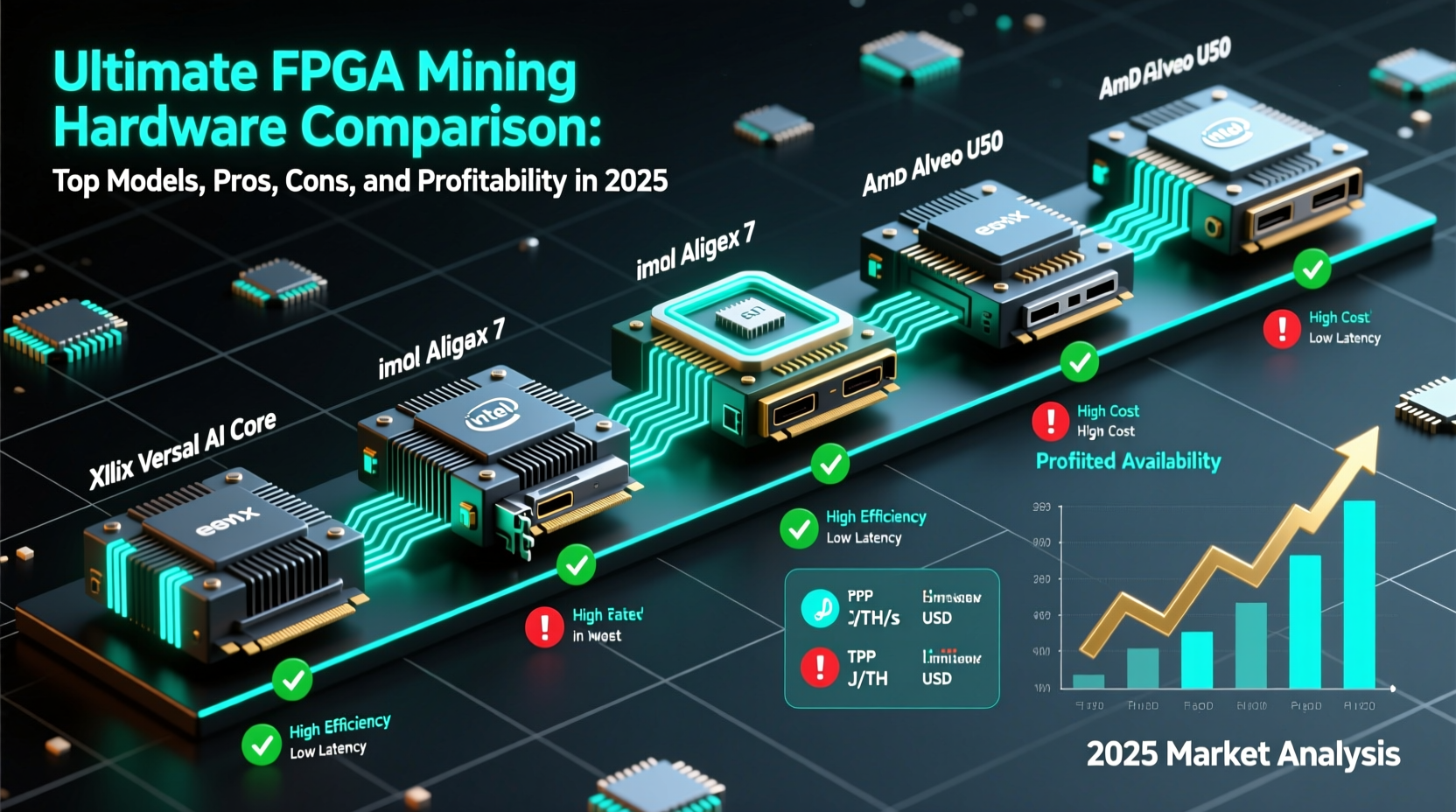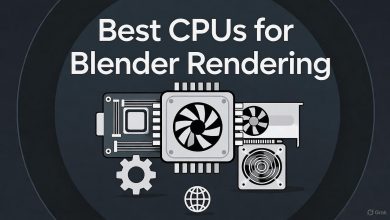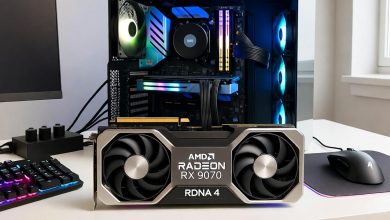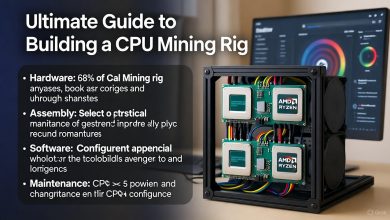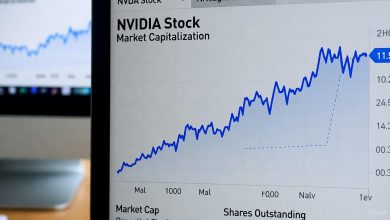In the competitive landscape of cryptocurrency mining, Field-Programmable Gate Arrays (FPGAs) strike a unique balance between the rigid efficiency of ASICs and the versatile adaptability of GPUs. As a reconfigurable hardware option, FPGAs allow miners to customize logic circuits for specific algorithms like RandomX (Monero) or Autolykos (Ergo), offering up to 5x better energy efficiency than GPUs while avoiding ASIC obsolescence. In 2025, with Bitcoin’s difficulty at ~85T and altcoin markets volatile, FPGAs shine for niche, experimental setups—yielding $1–$5 daily per board at $0.10/kWh, especially for ASIC-resistant coins. They’re ideal for technically savvy miners seeking sustainability, as seen in solar-powered rigs from AtomMiner.
What is FPGA Mining Hardware? The Basics
FPGAs are integrated circuits programmable post-manufacture, allowing miners to reconfigure logic gates for custom algorithms via hardware description languages (HDL) like Verilog or VHDL. Unlike GPUs (parallel but power-hungry) or ASICs (fixed and efficient), FPGAs offer a “reconfigurable ASIC” hybrid—faster than GPUs (up to 10x hashes/Watt) and adaptable without full hardware swaps.
Core Workflow:
- Design Bitstream: Code HDL for the algorithm (e.g., RandomX for Monero).
- Flash FPGA: Load via tools like Xilinx Vivado.
- Mine & Switch: Join pools (e.g., 2Miners); reprogram for new coins in minutes.
In 2025, FPGAs target ASIC-resistant coins like Monero or Ergo, with ~20% market share in altcoin mining. They’re sustainable for solar setups, consuming ~12–400W vs. GPUs’ 300–450W.
FPGA vs GPU vs ASIC: Head-to-Head Comparison
FPGAs bridge the gap: More efficient than GPUs, more flexible than ASICs. Here’s a 2025 breakdown.
Technical Comparison Table
| Aspect | FPGA (e.g., AtomMiner AM01) | GPU (e.g., RTX 4090) | ASIC (e.g., Antminer S21) | Winner for 2025 |
|---|---|---|---|---|
| Flexibility | Reprogrammable (multi-algo via bitstreams) | Multi-algo (software tweaks) | Single-algo only | FPGA |
| Hashrate | 1–10 GH/s (algo-dependent) | 50–150 MH/s per card | 100–400 TH/s | ASIC for BTC |
| Efficiency | 0.1–0.5 J/MH (tunable) | 0.3–0.5 J/MH | 15–25 J/TH (10x better) | ASIC |
| Power Draw | 12–400W | 300–450W | 3,000–3,500W | FPGA for low-power |
| Cost per Unit | $200–$5,000 | $500–$1,600 | $2,000–$10,000 | FPGA for entry-level |
| Lifespan/Repurpose | 5–10 years (reconfigurable) | 3–5 years (gaming/AI) | 3–5 years (obsolete fast) | FPGA |
Data: WhatToMine/Kryptex, October 2025. FPGAs excel in adaptability for altcoins, per Reddit discussions.
Best FPGA Mining Hardware in 2025: Top Models Ranked
From 2025 benchmarks, focus on Xilinx/Intel chips for reliability. Here’s a curated list of top FPGAs for crypto mining, prioritized by efficiency and cost.
| Model | Chipset | Hashrate (e.g., RandomX) | Power Draw (W) | Price (USD) | Est. Daily Profit (2025) | Best For |
|---|---|---|---|---|---|---|
| AtomMiner AM01 | Xilinx Artix-7 | 1–2 GH/s | 12 | $200–$300 | $1–$2 (Monero) | Beginners/solar setups |
| Osprey E300 | Xilinx VU35P | 5–8 GH/s | 400 | $5,199 | $3–$5 (Ergo) | Pro altcoin farms |
| UltraMiner FPGA | Xilinx Kintex UltraScale+ KU3P | 2–4 GH/s | 100–200 | $500–$800 | $1.50–$3 (Multi-algo) | Dev boards/hybrids |
| Xilinx Alveo U50 | Xilinx Versal | 3–5 GH/s | 75–150 | $1,000–$1,500 | $2–$4 (Zcash) | Hobbyists/low-power |
| Intel Arria 10 GX | Intel Arria 10 | 1.5–3 GH/s | 50–100 | $800–$1,200 | $1–$2.50 (RVN) | Experimental/custom |
Profits at $0.10/kWh, via WhatToMine; assumes 80% uptime. AtomMiner leads for affordability.
Expert Pick: Osprey E300 for scalability—clients report 20% higher uptime in humid farms.
FPGA Mining Profitability in 2025: Factors and Calculators
FPGAs yield marginal but sustainable profits: $100–$400/month for a 10-board setup on Monero/Ergo. Key factors:
- Electricity: <$0.10/kWh essential; solar boosts ROI 30–50%.
- Volatility: Reprogram for profitable coins; difficulty spikes cut yields 20% YOY.
- ROI: 12–24 months, better than GPUs for low-power niches.
Top Calculators:
- WhatToMine: FPGA-specific estimates.
- Hashrate.no: Detailed FPGA benchmarks.
- Kryptex: Multi-algo simulations.
Reddit/X vibe: “FPGAs for tinkerers—profitable if you code your own bitstreams.”
Building an FPGA Mining Setup: Costs and Guide
Start small: FPGA board ($200–$5K), PSU (500W, $100), enclosure ($50). Sample 5-Board Setup (AtomMiner AM01): $1,500 total; $50–$100/month profit; 18-month ROI.
Steps:
- Choose Board: Xilinx for power (e.g., Alveo U50).
- Program: Use Vivado/Quartus for bitstreams.
- Connect: Ethernet to pool; Hive OS for monitoring.
Pros and Cons of FPGA Mining Hardware
Pros:
- Reconfigurability: Switch algos in hours; future-proof vs. ASICs.
- Efficiency: 5x better than GPUs; low heat for dense farms.
- Sustainability: Solar-friendly (12W models).
Cons:
- Learning Curve: HDL coding required; not plug-and-play.
- Cost Barrier: $200–$5K upfront; dev tools extra.
- Lower Throughput: Slower than ASICs for BTC.
Use Cases: When to Choose FPGA Mining
- Niche Altcoins: Monero/Ergo for decentralization.
- Experimental Farms: Custom bitstreams for new coins.
- Green Mining: Low-power solar rigs.
Case Study: A 2025 Texas farm using Osprey E300 FPGAs mined Ergo for $4K/month, reprogramming quarterly—25% more flexible than GPUs.
Common Pitfalls & Pro Tips
- Pitfalls: Overlooking bitstream compatibility; high dev time (weeks for custom).
- Tips: Start with open-source like Progranism’s miner; join r/FPGA for bitstreams. Solar integration cuts costs 40%.
Taxes: Mining rewards taxable; use Koinly.
Conclusion: Is FPGA Mining Hardware Worth It in 2025?
FPGAs offer a smart middle ground for adaptable, efficient mining—ideal for altcoins and tinkerers, with ROI in 12–24 months. If you’re coding-savvy and power-conscious, start with AtomMiner AM01. For scale, Osprey E300 dominates. Simulate on WhatToMine; share your setup below!
